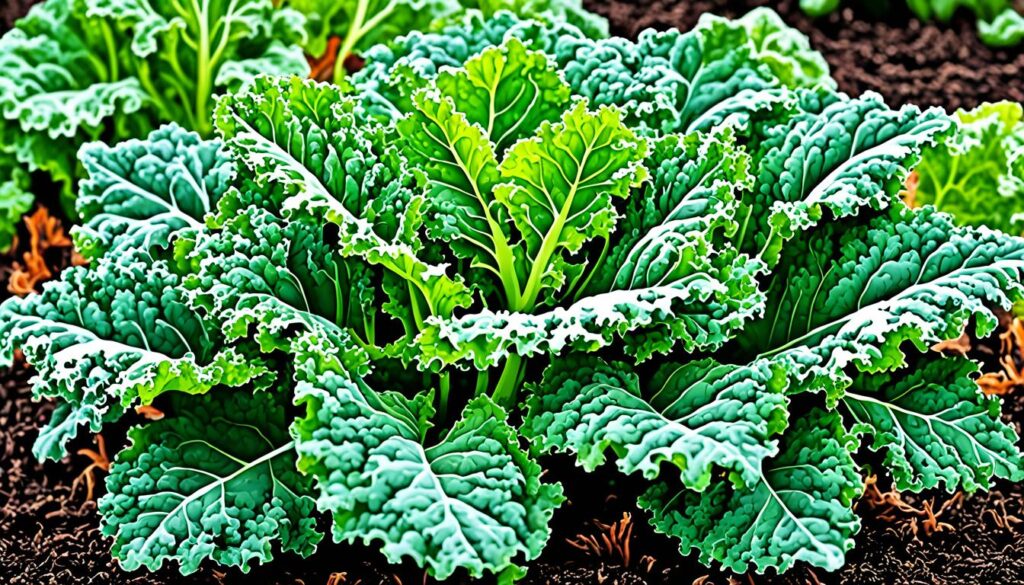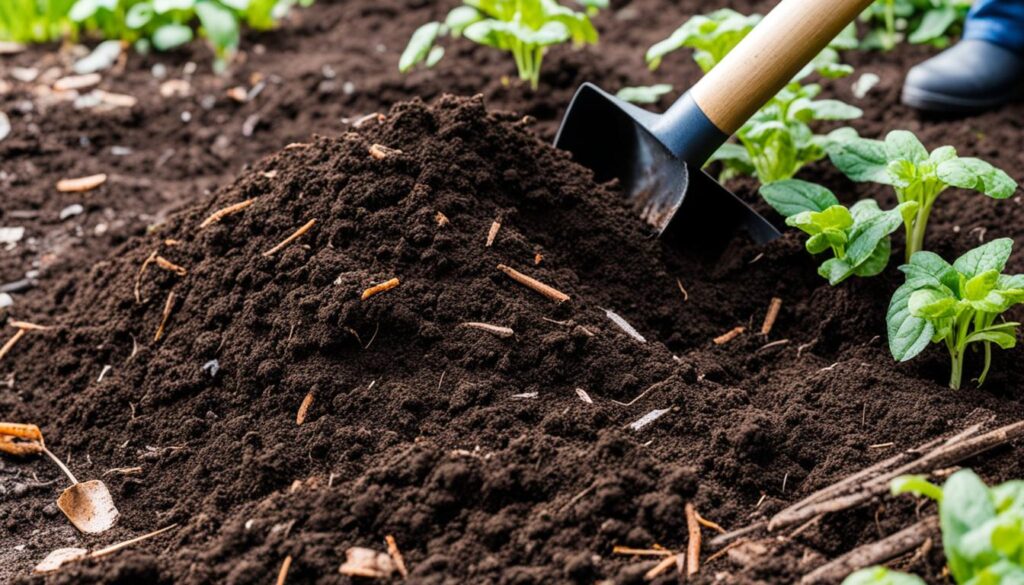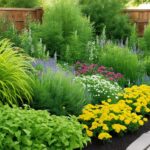In northern California, my garden comes alive in winter, thanks to the intense rains and the ability to handle frosts1. I plan carefully to get vibrant greens during the cooler months. Vegetables like spinach and kale grow well in warm soil at first, then handle the cold12. My garden has three raised beds with cool-weather plants, including a legume mix that enriches the soil for next year1. With the right plants and care, any garden can be a winter wonderland of fresh food.
Key Takeaways
- Winter gardening is not only possible but prolific with the right plant selections and care.
- Bed layout and soil temperature significantly influence the success of garden plants.
- Cover crops like legume mixes play a vital role in maintaining soil health during winter.
- Plant staggering and cover strategies extend the harvest cycle and protect vulnerable species.
- Despite the cold, certain landscapes can support a wide variety of plant species year-round.
- A cornerstone of successful winter gardening is the dedication to nurturing soil health.
- Community resources, like Master Gardener Help Desks, offer valuable advice for winter gardening challenges.
Embracing the Cold: Hardy Garden Plants That Flourish in Winter
Winter brings a special charm to gardening, changing the landscape and offering a chance to grow hardy plants. These plants are tough, making gardening a year-round activity that’s both productive and fun.
Benefits of Growing Winter Vegetables
Winter gardening is rewarding, especially with plants like arugula and kale. They love the cold and taste sweeter than in warmer months3. Spinach also does well in the cold, giving you fresh greens all season3.
Leafy Greens That Survive Harsh Conditions
Some leafy greens are super tough in winter. Mache is one, surviving the cold to give you nutritious greens3. Swiss chard is another, great for both summer and winter, making it a must-have for winter gardens3.
Protective Covering Strategies for Sub-Freezing Temperatures
To keep these hardy plants going, using frost blankets is a good idea. These covers can warm up the inside by 2-8 degrees Fahrenheit, helping semi-hardy plants survive the cold4.
| Plant Type | Hardiness | Benefits in Winter |
|---|---|---|
| Kale | Extremely hardy | Sweeter leaves in cooler temperatures3 |
| Swiss Chard | Hardy | Versatile growth throughout seasons3 |
| Spinach | Hardy | Performs better in cold weather3 |
| Arugula | Hardy | Flourishes in cooler temperatures, sweeter taste3 |
Adding these vegetables to your garden makes it look great in winter and gives you fresh food when most gardens sleep. Whether you’re an expert or new to winter gardening, these plants will make your efforts pay off with beautiful and fruitful results.
Garden Plants Suited for Snow, Rain, and Ice
Winter brings out the best in some garden plants. Carrots and turnips are great examples. They love the cold and grow well under snow.
Carrots: A Versatile Cold-Weather Favorite
Growing carrots in winter was a big surprise for me. As it gets colder, carrots get sweeter. This is because the cold turns their starches into sugars.
They do best in full sun to partial shade and well-drained soil. This helps them grow and taste better. It’s good advice for all garden plants.
Turnips and Their Enhanced Flavor from Late Summer Sowing
Turnips get tastier when sown in late summer. They’re key for my cooking and keep my garden healthy in winter. They can even grow in cold weather, down to 40-degrees Fahrenheit5.
These veggies make my garden richer and more diverse. Adding them helps keep the soil active, prevents erosion, and gives me fresh food when stores are empty.
Carrots and turnips make my garden thrive in winter. They show that even with snow, rain, and ice, our gardens can be full of life. As a gardener, winter is a chance to keep harvesting and enjoying the fruits of our labor.
Mastering Winter Horticulture: Expert Tips for a Thriving Vegetable Garden
As a passionate gardener, I’ve discovered the joys of winter gardening. It’s a chance to grow crops like Brussels sprouts, known for their toughness in cold weather. I’m excited to share tips for a successful winter garden, focusing on Brussels sprouts.
Optimal Growing Conditions for Brussels Sprouts in Winter
Brussels sprouts do well in cold weather, making them a great choice for winter gardens. Plant them about four months before the first frost. They need well-draining soil and full sun to some shade. Protect young plants from strong winds and keep them moist as they grow.
Experts like Mattus highlight the need for these conditions. His book, “Mastering the Art of Vegetable Gardening,” is full of helpful tips and illustrations6.
Choosing the Right Zone for Your Winter Garden
Picking the right hardiness zone is key for winter gardening. It means knowing your area’s temperature and seasonal patterns. In very cold areas, choose Brussels sprouts that can handle freezing temperatures, even down to 20 degrees.
Local gardening groups or guides can offer great advice for your region. Kyle Crawford from Ladybird Farm suggests using winter rye as a cover crop. It protects the soil during harsh seasons7.
Winter gardening is more than just surviving the cold. It extends the gardening season, letting you enjoy fresh produce and the beauty of nature all year. By understanding plant care and your local climate, you can have a successful winter garden. This includes growing Brussels sprouts and other hardy varieties.
Mustard Greens and Robust Lettuces: Winter Garden Essentials
As winter comes, adding Mustard Greens and strong lettuces to your garden is key. They keep your garden fresh and full of nutrients. These plants love the cold, making them perfect for organic gardening lovers.
Starting seedlings indoors in fall helps your harvest last longer into winter8. Mustard Greens can handle light frosts and need little care in cold frames or mini tunnels8.
Lettuces like ‘Winter Density’ and ‘Rouge D’Hiver’ taste better in the cool. They grow well with Mustard Greens, making great winter salads8.
- Greens like lettuce and spinach need one inch of water a week and grow best in the fall sun9.
- They do well in sandy soil for good drainage and easy sowing9.
- Use deep containers (6-8 inches) for winter greens to support their deep roots9.
Good plant care means adjusting to the seasons with shelter and water. Using row covers and hoop tunnels helps protect your plants from winter and boosts their yield8.
Every season, organic gardening brings new colors and textures with Mustard Greens and lettuces. With planning and care, you can have a bountiful harvest that makes your winter meals better.
Garden Plants That Brave the Frost: A Guide to Winter Cabbage and Broccoli
Growing winter-friendly vegetables like winter cabbage and broccoli is rewarding. These plants are tough and perfect for cooler seasons. They are key to organic gardening and do well in greenhouses.
Utilizing Greenhouses for Brassica Crops
Using greenhouses helps improve your brassica crops’ yield and health. Broccoli does well in cold weather and can handle temperatures as low as 28°F. It’s best planted in late summer for a strong early winter harvest10. Greenhouses protect these plants from harsh weather and let them grow longer than they would outside.
Organic Gardening Solutions for Winter Pest Control
Keeping winter cabbage and broccoli healthy means controlling pests. Use organic methods to keep pests like cabbageworms away. This can include using natural predators, barriers, or organic sprays. A thick layer of mulch also helps by keeping pests away and keeping the soil warm and moist.
A good balance between protection and growing conditions is key for a healthy garden. Broccoli gets better with multiple frosts, making it tastier and crunchier11. Winter cabbage planted close together can also protect each other from the cold, showing how strategic planting helps them survive11.
| Vegetable | Minimum Temperature Tolerance | Optimal Planting Season |
|---|---|---|
| Winter Cabbage | 26°F | Late Summer |
| Broccoli | 28°F | Early Fall |
| Kale | 20°F | Mid-Summer |
| Radishes | 20°F | Autumn |
Whether you garden for fun or for food during winter, knowing these tips helps. It ensures a good harvest of winter cabbage and broccoli. It also makes organic gardening and pest control easier. As we face the frost, let’s keep our gardens thriving and our spirits high.
Optimizing Plant Care in Winter: Key Considerations for Healthy Kale
Winter Gardening with kale needs careful planning to help it grow well in the cold. This leafy green is not only a kitchen favorite but also packed with nutrients. It does best in cooler climates. Understanding how to care for kale, especially with Soil Moisture and Light Requirements, is key.
Soil Moisture and Light Requirements for Kale
Kale needs soil that drains well and stays moist to keep its leaves tender. It likes full to partial sun, making it perfect for winter gardens. Kale is also a nutrient powerhouse, having the most nutrients per calorie among 72 other foods12.
To keep kale healthy, check the soil moisture often. Stick your finger into the soil up to your knuckle to see if it needs water. If it’s too dry, kale won’t grow well. If it’s too wet, it might rot.
Light is also crucial for kale. It does best with 6 to 8 hours of sunlight daily. Without enough light, kale won’t grow thick and healthy leaves. With the right amount of light, your kale will be ready to eat soon.
Placing kale in the right spot can also help. Put it where it gets winter sun but is protected from strong winds. This is especially important in places like the Willamette Valley of Oregon, where kale grows well12.

Adding kale to your winter garden makes the most of your space and keeps you busy all year. This planning means you’ll have fresh veggies during the cold months13.
In conclusion, knowing how to manage soil moisture and light will make your kale thrive in winter. These tips are great for both new and experienced gardeners. They help you enjoy your winter garden more.
Winter Flowers That Add Color to Your Garden
I love adding winter-blooming flowers to my winter garden. They make the garden look beautiful and keep it lively during the cold months. These flowers bring joy and color to the garden when it’s usually bare.
The hardy Primrose is one of my top picks, starting to bloom in March. It grows 6 to 12 inches tall and comes in many colors, perfect for zones 4-814. Another favorite is the Winter Jasmine, which can grow up to 15 feet tall with support. It blooms in late winter in zones 6-1014. This shrub adds a bright yellow splash that looks great against the snow.
| Flower | Bloom Period | Zone | Height |
|---|---|---|---|
| Camellias | Mid to Late Winter | 7-10 | 6-12 feet |
| Hellebores | Mid to Late Winter | 4-9 | Up to 24 inches |
| Winter Heath | January to March | 5-7 | 6-12 inches |
| Witch Hazel | January to March | 4-8 | 10-20 feet |
Adding these flowers to my garden makes it look better and helps local bees. The Winter Heath blooms from January to March and bees love it14. Witch Hazel has bright yellow flowers that light up the garden even in snow15.
I keep working on my winter garden to make it both beautiful and useful. This way, my garden not only makes it through winter but also stays vibrant and full of life. It becomes a beautiful place filled with color and texture during the cold season.
Garden Plants Seed Sowing: Timing and Techniques for Winter Gardening Success
As a gardening enthusiast, I know that timing and technique are key in winter gardening. Planting seeds in the cold months is more than keeping my green thumb busy. It’s about planning and using strategies like indoor gardening and succession planting for a year-round vegetable harvest.
First, indoor gardening in the cold season is crucial. It protects seedlings from harsh weather and helps them grow well. Winter sowing seeds directly outdoors works well for hardy vegetables like kale and lettuce16. You can use simple containers like milk jugs or take-out boxes, which are easy to find and cheap17.
Starting Seedlings Indoors for a Head Start
When starting seedlings indoors, I use top-quality potting soil and space seeds about an inch apart16. They need a sunny windowsill to get enough light during the short winter days. This method not only starts their growth but also keeps them safe until they can go outside.
Succession Planting for an Extended Harvest
Succession planting is key for continuous winter produce. It means planting seeds at different times to avoid harvesting everything at once and extend the growing season18. This is great for vegetables, keeping fresh greens coming even in the cold months.
Here’s a table comparing different containers for winter sowing. It helps you pick the best one for your garden:
| Container Type | Suitability for Seed Type | Notes |
|---|---|---|
| Milk Jugs | Vegetables, Perennials | Ample space, easily available |
| 2-Liter Soda Bottles | Small Seeds: Herbs, Flowers | Compact, easy to place |
| Take-out Containers | Annuals, Greens | Shallow, best for small plants |
| Salad Containers | Herbs, Small Vegetables | Prevents soil compression |
In conclusion, each plant has its own needs for light, soil, and space. For successful winter sowing17, follow the best practices here. With care and planning, your indoor and winter gardening will bring fresh vegetables all season!
Organic Gardening: Nutrient-Rich Soil for Optimal Plant Health
Organic gardening is all about making sure the soil is rich in nutrients. This is key for healthy plants and a strong garden ecosystem.
Composting and Soil Amendments for Winter Gardens
Every winter, I work on my garden soil with composting and soil amendments. Adding 1 to 2 inches of compost 6 to 8 inches deep helps my flowers and veggies grow strong19. For trees and shrubs, I mix in 4 inches of compost 12 inches deep to help them grow well19.
My compost turns kitchen scraps and yard waste into soil helpers. It creates tiny pockets of air and water that roots and microbes need19. I also avoid harsh chemicals, using things like horticultural oils instead, to keep pests away19.
Understanding Soil Chemistry for Garden Plant Success
Soil chemistry is important for my garden. Loam soil, with its mix of sand, silt, and clay, is perfect for my plants20. Vegetables do best in slightly acidic soil, which helps them grow strong and produce more20.
Sometimes, I need to adjust the soil’s pH. Adding things like crushed limestone or peat moss helps20. Mixing 50% topsoil, 30% compost, and 20% other materials in my garden beds also helps with growth and drainage20.

By composting, understanding soil chemistry, and making smart soil changes, I keep my garden thriving. It’s a place of joy, sustainability, and organic gardening at its best.
| Nutrient | Benefit | Source |
|---|---|---|
| Nitrogen, Phosphorus, Potassium | Essential for growth and vitality | Compost, Soil Amendments |
| Iron, Manganese, Zinc | Supports enzyme functions and photosynthesis | Soil Amendments |
| Organic Matter | Improves soil structure and moisture retention | Compost |
Landscaping with Garden Plants: Creating a Visually Pleasing Winter Garden
I love turning outdoor spaces into stunning landscapes. Landscaping with garden plants is more than making it look good. It’s about planning and knowing your garden’s ecosystem. Mixing decorative and edible plants makes the garden beautiful and useful, even in winter.
Integrating Decorative and Edible Plants for Aesthetic Appeal
Picking the right plants is key for a beautiful garden. In my garden, plants like Winterberry ‘Winter Red’ and Blue Holly ‘Blue Princess’ stand out in winter21. They offer structure and attract birds, making the garden lively21. I also use kale and winter lettuces for their greenery and usefulness.
Strategic Layout Planning for Year-Round Enjoyment
Layout is crucial for a garden that looks great all year. I aim for a balanced design with color, form, and texture. Ornamental grasses add color and interest, and are placed to catch the light21. They complement evergreen plants like Arborvitae ‘Berkman’s Gold’ and Inkberry Holly ‘Shamrock’21.
Mulching and pruning keep the garden healthy and looking good in winter22. Mulching protects the soil and keeps the garden looking nice. Using winter containers adds color and flexibility22.
Every plant and design choice aims for a beautiful winter landscape. This makes the garden a cozy and inviting spot, even when it’s cold.
Conclusion
Starting a winter garden shows us how strong nature is and how important gardening is for our health. Studies show that being around nature helps people recover faster after surgery23. Gardening is not just about growing food; it also makes us healthier, as seen with indoor plants helping people get better23.
Winter gardening takes a lot of work, but it’s worth it. We get to enjoy beautiful plants like roses and marigolds, and feel close to nature24. This kind of gardening is good for our mental health, making us feel whole23. Plus, eating veggies from our own garden tastes way better than store-bought ones, showing how rewarding gardening is24.
So, growing a winter garden is good for the planet and our health. It turns a quiet garden into a colorful place, even in the cold2324. This season lets us eat fresh, healthy food and enjoy the peace and energy gardening brings2324.
FAQ
What are the benefits of growing winter vegetables?
Which leafy greens are best suited for surviving harsh winter conditions?
How can I protect my sub-freezing temperature-sensitive plants?
What makes carrots a versatile favorite for cold weather?
How do turnips benefit from late summer sowing?
What are the optimal growing conditions for Brussels sprouts in winter?
How do I choose the right zone for my winter garden to thrive?
Can I use greenhouses for growing Brassica crops in winter?
What organic solutions can I use for winter pest control in my garden?
What are the soil moisture and light requirements for growing kale in winter?
How can I add color to my winter garden with flowers?
What techniques should I use for starting seedlings indoors for my winter garden?
How can succession planting extend my winter harvest?
Why is composting and soil amendment important for winter gardens?
How do I understand soil chemistry for optimal garden plant health?
How can I create a visually pleasing winter garden through landscaping?
Why should I plan for a strategic layout in my winter garden?
Source Links
- A Winter Vegetable Garden in Northern California – Fine Gardening – https://www.finegardening.com/article/a-winter-vegetable-garden-in-northern-california
- It’s Not Too Late to Plant Your Winter Garden – https://acmg.ucanr.edu/Over_the_Fence/Its_Not_Too_Late_to_Plant_Your_Winter_Garden/
- 10 Cold Hardy Vegetables to Grow in Winter – https://embracingharvest.com/cold-hardy-vegetables-to-grow-in-winter/
- Annuals That Can Take the Cold – https://thegardendiaries.blog/2024/02/28/annuals-that-can-take-the-cold/
- 13 Tough But Pretty Perennials That Will Breeze Through Harsh Winters – https://www.bhg.com/gardening/flowers/perennials/perennials-designed-to-survive-harsh-winters/
- Mastering the Art of Vegetable Gardening – Fine Gardening – https://www.finegardening.com/article/mastering-the-art-of-vegetable-gardening
- Advice from a Professional Vegetable Gardener – https://piedmontmastergardeners.org/article/advice-from-a-professional-vegetable-gardener/
- Cool Season Salad Greens – Mother Earth Gardener – https://www.motherearthgardener.com/organic-gardening/cool-season-salad-greens-zmaz13fzcbru/
- Growing Leafy Greens in Iowa – https://yardandgarden.extension.iastate.edu/how-to/growing-leafy-greens-iowa
- 10 Easy to Grow Winter Crops – https://www.dripworks.com/blog/10-easy-to-grow-winter-crops?srsltid=AfmBOoqAfWUDGSsiVHrBh-L_dt2mjVIC5z6bueZ18WiFgevnet2cbAX8
- Frost in the Garden – The Permaculture Research Institute – https://www.permaculturenews.org/2020/11/26/frost-in-the-garden/
- No-Fail Kale: The Powerful Health-Benefits of Kale and How to Grow It – https://thesharinggardens.blogspot.com/2019/04/no-fail-kale-growing-kale-and-saving.html
- Winter Vegetable Gardening: A Complete Guide to Four-Season Growing | French Creek Farmhouse – https://www.frenchcreekfarmhouse.com/2023/10/winter-vegetable-gardening.html
- 16 Winter Flowers for a Colorful Cold-Weather Garden – Garden Design – https://www.gardendesign.com/flowers/winter.html
- Plant These Winter Flowers to Brighten Up Your Garden or Landscape – https://www.countryliving.com/gardening/garden-ideas/g30304960/winter-flowers/
- Winter sowing: An Easy, Low-Cost Technique for Starting Seeds – https://savvygardening.com/winter-sowing/
- Winter Sowing for a Bountiful Harvest — Enchanted Gardens – http://www.enchantedgardensdesign.com/blog/2022/1/29/winter-sowing-for-a-bountiful-harvest
- Simple Seed Starting Using Winter Sowing – https://thegardendiaries.blog/2023/12/29/simple-seed-starting-using-winter-sowing/
- Living soil, healthy garden – https://extension.umn.edu/managing-soil-and-nutrients/living-soil-healthy-garden
- How to Create Organic Soil for Your Healthiest Garden Ever – https://www.bhg.com/gardening/yard/soil/creating-rich-organic-soil-in-your-garden-281474979752803/
- Plants That Bring Visual Interest to your Winter Garden – https://www.bahlerbrothers.com/blog/plants-that-bring-visual-interest-to-your-winter-garden
- Winter Garden Design: Your Guide to a Cold-Season Paradise – Urban Earth – https://urban-earth.co.uk/winter-garden-design/
- Gardening for health: a regular dose of gardening – https://www.ncbi.nlm.nih.gov/pmc/articles/PMC6334070/
- Essay on Garden for Students and Children | 500+ Words Essay – https://www.toppr.com/guides/essays/essay-on-garden/


